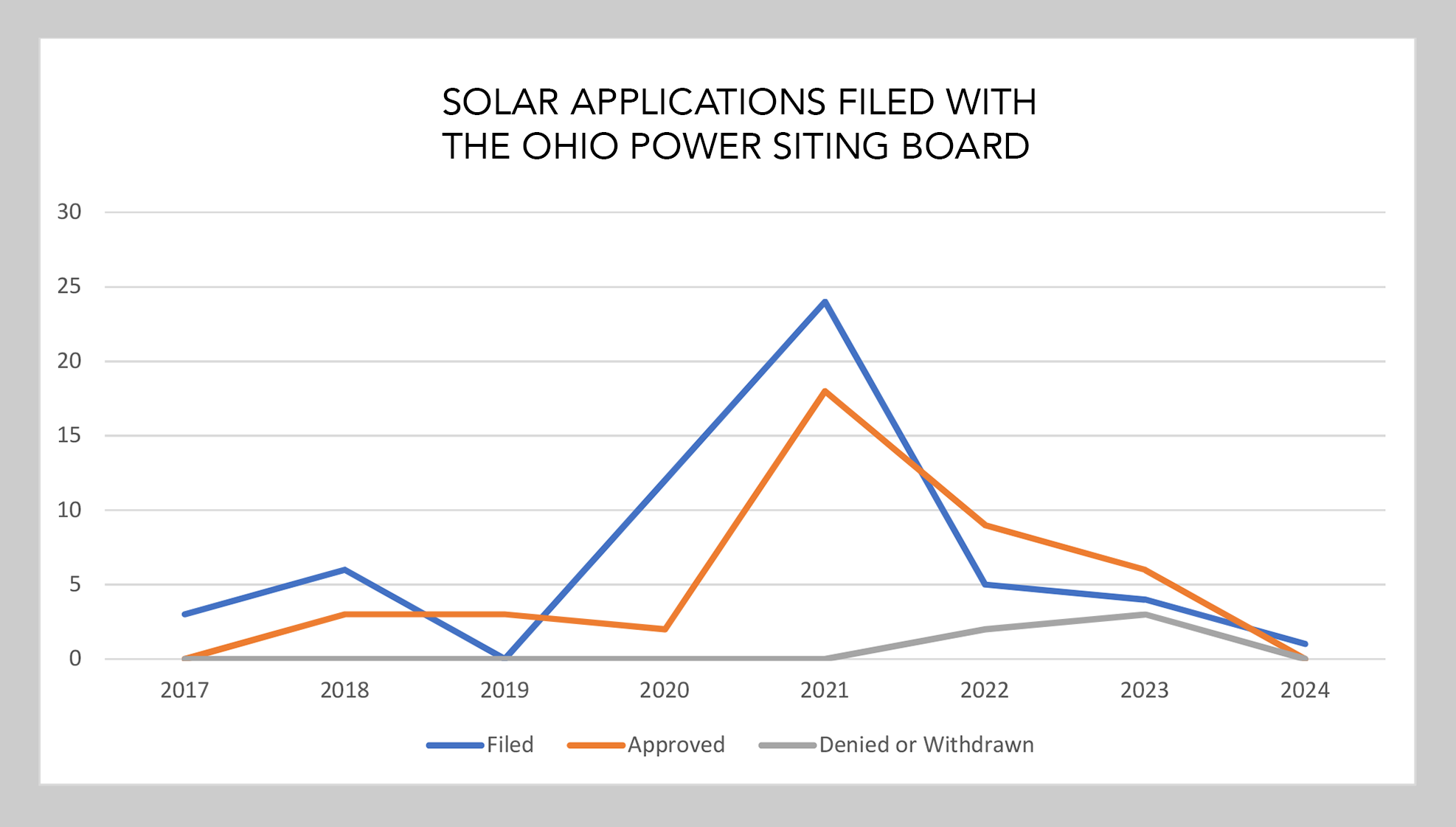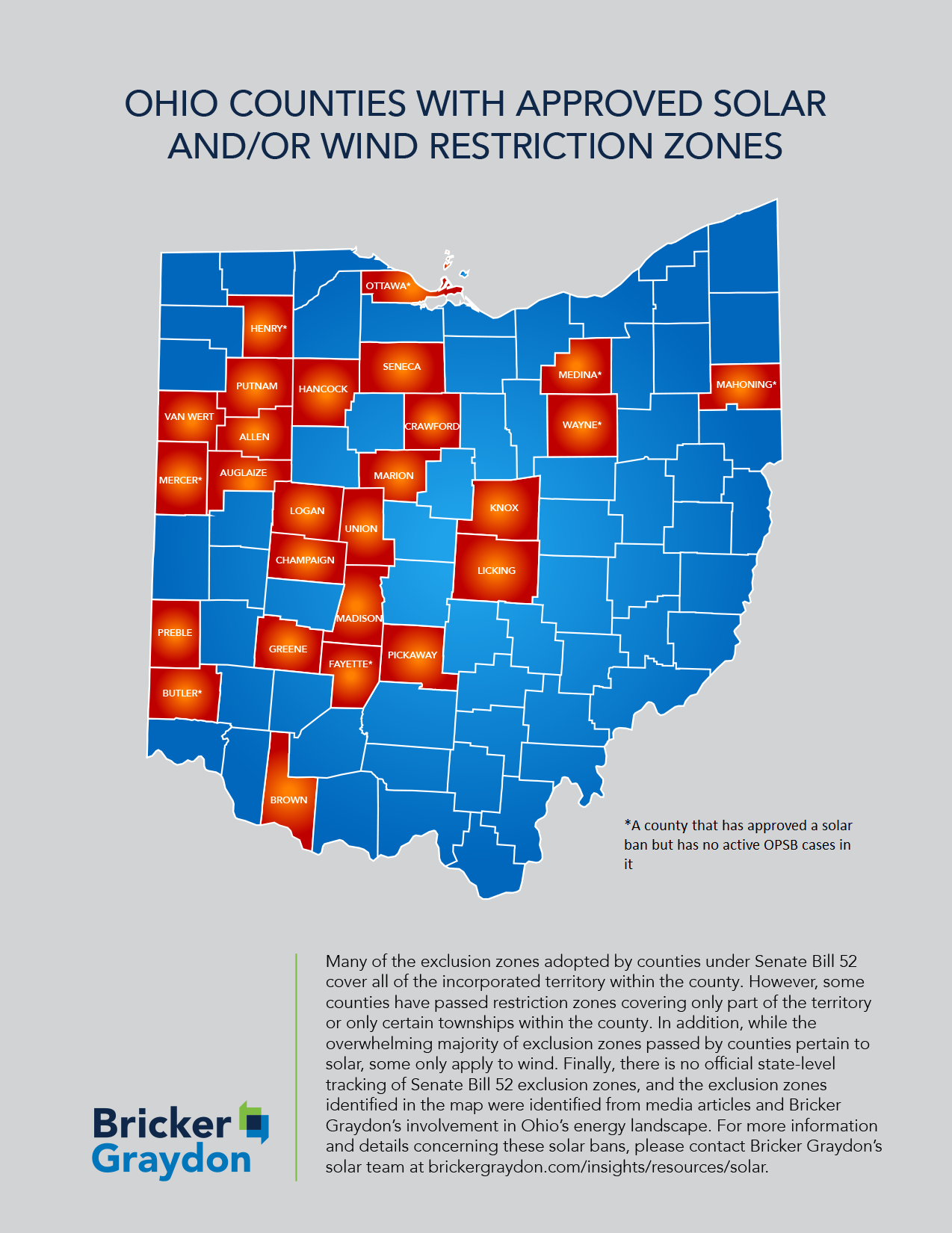While 2023 was another active year for utility-scale solar development and activity in Ohio, there was a marked decrease in applications filed with the Ohio Power Siting Board (OPSB), as well as a decrease in project approvals and continuing trend of OPSB project denials. Many of the subjects identified in last year’s version of this article continue to be relevant.[1]
This article summarizes the key Ohio utility-scale solar events of 2023 and highlights trends and issues heading into 2024, including:
- Fewer solar applications submitted to OPSB
- More counties pass solar bans, including those without proposed projects
- OPSB adopts new rules for solar siting
- OPSB establishes enhanced agricultural protection and grading requirements in project conditions
- Ohio General Assembly modifies requirements for solar payment-in-lieu-of-taxes (PILOT)
- OPSB’s “public interest” denials appealed to Ohio Supreme Court
- Other Ohio Supreme Court solar-related activity
- Ohio General Assembly passes HB 501 to expressly authorize local zoning of solar under 50 MW
Fewer solar applications submitted to OPSB
Applications to the OPSB declined in 2023, continuing a steep decrease in new project permitting activity in Ohio. Despite growing demand from Ohio corporations and communities to procure in-state renewable energy, a number of challenges are negatively impacting development decisions. As discussed in last year’s recap article, development timelines continue to be impacted by tariff uncertainty and supply chain issues. Additional state-level barriers are also making the development of new supply more difficult.
First, the number of projects that are grandfathered from the local permitting reforms adopted under Senate Bill 52[2] in 2021 is increasingly dwindling. These projects also face additional permitting uncertainty around the OPSB’s recent “public interest” denials based on local opposition, which some observers view as a departure from previous OPSB precedent (discussed further below).
Second, projects not qualifying for grandfathered status are subject to bans passed by counties under Senate Bill 52 (also discussed further below). More counties passed such bans in 2023, including in multiple counties without previous experience with large-scale solar projects. Projects have also faced interconnection delays and challenges at the Pennsylvania-New Jersey-Maryland Interconnection (PJM) as it emerges from its two-year pause and implements the reformed queue process.

The permitting uncertainties faced by projects grandfathered under Senate Bill 52 and the increase in outright solar bans preemptively prohibiting non-grandfathered projects means Ohio will likely see a continued decrease in new supply opportunities in the coming years.
More counties pass solar bans, including counties without proposed solar projects
Senate Bill 52 gave counties the power to review and block an individual project prior to the OPSB process, even when OPSB has exclusive jurisdiction because a project is in excess of 50 megawatts (MW). The purpose of this local review process was to allow counties to review the benefits and local impacts of every unique project and to determine which, if any, are a good fit for the county. But much further than this review process, Senate Bill 52 also empowered counties to pass restriction zones over all or part of the county preemptively rejecting all new solar projects. In 2023, more counties passed these blanket bans. Whereas many counties with multiple solar projects have opted to restrict further development, this year saw a number of counties without any prior OPSB-jurisdictional projects preemptively banning solar.
OPSB adopts new rules for solar siting
In July 2023, OPSB adopted a comprehensive set of rules governing procedure and siting criteria. This Order was the culmination a multi-year process that began with a series of workshops at the onset of the COVID-19 pandemic and a subsequent stakeholder comment process through 2022. Much of the rulemaking’s focus was modifying the existing rules to address issues related to solar development. Such modifications included the adoption of solar project setback, fencing, and drain tile management standards. The rules also establish additional preapplication public information meeting and notice requirements, as well ongoing compliance monitoring and reporting requirements to ensure approved projects meet the commitments and conditions contained in each OPSB certificate.[3] In December 2023, OPSB granted rehearing on a limited set of rule revisions. After the final order from the OPSB, the rules will be sent to the Joint Committee on Agency Rule Review and then to the Ohio Secretary of State’s office before becoming effective. It is estimated that the new rules will become effective sometime in Q2 of 2024.

OPSB establishes enhanced agricultural protection and grading requirements in project conditions
One of the primary areas of misalignment between local communities and project developers is the tension between individual land use rights and the concern that solar development represents a loss of farmland. To further address this balance, OPSB has included additional requirements in approved permits (conditions) to protect the long-term opportunity for the solar project area to be returned to agricultural production after the project is decommissioned. Over the last year, OPSB has included, as a condition, the development of a comprehensive Agricultural Protection Plan (APP) designed to minimize impacts to agricultural land use during the construction, operation, maintenance, and decommissioning. In part, the APP must implement a soil testing process to establish the baseline preconstruction soil conditions and to require the restoration of the site to these baseline conditions. Grading under the APP must be limited, with a goal of limiting grading to 5% of the project area, with a firm limit of 20%. The APP requirements also include a number of topsoil management best practices for areas in which there is disturbance.
The APP appears to now be a standard condition at OPSB, although it may evolve in 2024 to refine how agricultural land use concerns are addressed and account for unique project areas.
Ohio General Assembly modifies requirements for solar payment-in-lieu-of-taxes (PILOT)
The primary property tax abatement vehicle used by renewable energy projects in Ohio is the Qualified Energy Project (QEP). Originally passed in 2010, the QEP program enables qualifying projects to receive an abatement of real and personal property taxes in exchange for payment-in-lieu-of-taxes (PILOT). On June 30, 2023, the Ohio General Assembly, as part of the state’s biennial budget bill (House Bill 33), further extended the construction and operation deadlines of the QEP Program. In addition to the extension, the new law makes a number of substantive revisions to the program. The most significant change is the modification of the Ohio-domiciled workforce for solar construction from an 80% requirement to 70%, along with additional wage and apprenticeship requirements.
OPSB’s “public interest” denials appealed to Ohio Supreme Court
Beginning in 2022, OPSB for the first time denied solar projects for failing to meet the legal requirement that the project be in the “public interest.” The basis for these three denials did not involve particular issues or impacts, but rather purported “unanimous” local government opposition to the projects. The projects receiving these denials have all challenged this determination, arguing that the deference to local opposition is contrary to the purpose of a state siting framework, violates Ohio law, and ignores previous OPSB precedent. In 2023, OPSB denied applications for rehearing for Birch Solar and Kingwood Solar on this basis. Both projects have appealed to the Ohio Supreme Court.
Briefing in the Birch Solar case concluded on January 22, 2024. A broad coalition of amici curiae filed briefs in support of project’s challenge to OPSB’s ruling, covering environmental, labor, manufacturing, economic development, local, and industry concerns. Amici included the Ohio Chamber of Commerce, National Resources Defense Council, the International Brotherhood of electrical Workers Local Union 32, the American Clean Power Association, the Mid-Atlantic Renewable Energy Coalition, the Utility Scale Solar Energy Coalition of Ohio, the Ohio Environmental Council, the Ohio Manufacturers’ Association, the Ohio Independent Power Producers, and the Allen Auglaize Coalition for Reasonable Energy. Amici, such as Ohio Independent Power Producers representing a consortium of natural gas plants, argued that “the OPSB’s decision in Birch erodes a fair and predictable permitting process upon which new investment in power generating facilities in Ohio relies.” In support of the OPSB’s decision, local governments opposed to the Kingwood project filed a brief arguing in favor of a local veto.
Briefing in the Kingwood Solar Ohio Supreme Court appeal will conclude in early 2024. Oral arguments in both cases will likely occur in the first half of 2024, with decisions from the Court potentially later in the year.
Another solar project denied by OPSB on “public interest” grounds, Cepheus Solar, filed an application for rehearing at the OPSB in February of 2023, which remains outstanding.
Other Ohio Supreme Court solar-related activity
In October 2023, the Ohio Supreme Court issued its opinion in the consolidated appeals of Alamo Solar and Angelina Solar. Both projects had been approved by OPSB in 2021 with nearly all of the local governments joining in stipulations. A citizen group appealed to the Court, generally arguing that the projects failed to provide sufficient information regarding environmental and local impacts. The Court affirmed the OPSB approvals and ruled that the projects had provided the information required by the regulations. The Court also reaffirmed that OPSB may conditionally approve projects subject to its Staff review and approval of additional details later on.
In its decision, the Court took the opportunity to reject a long-standing tenet of agency review. The Court ruled that no judicial deference should be given to an agency's interpretation of its own rules and regulations, a departure from federal case law and prior Ohio precedent.
Shortly before the decision in Alamo and Angelina was issued, a local resident filed a similar appeal of the OPSB's approval of another project, South Branch Solar. Briefing closed on January 22, 2024, and the appeal is pending before the Court.
Ohio General Assembly passes HB 501 to expressly authorize local zoning of solar under 50 MW
In early 2023, Ohio House Bill 501 was enacted to grant local governments the express authority to pass zoning restrictions on solar projects with a capacity below 50 MW (under Ohio law projects 50 MW or greater fall under the OPSB’s exclusive jurisdiction).
In June 2023, an Ohio appellate court ruled that a 40 MW project Woodstock Solar, which was not subject to HB 501, was exempt from local zoning because it qualified as a public utility pursuant to R.C. 519.211(A). Under this analysis, the Woodstock project was found to provide an essential good or service to the general public. The Ohio Supreme Court denied a jurisdictional appeal from the local zoning commission.
[1] Last year’s overview article can be accessed here: https://www.brickergraydon.com/insights/publications/Ohio-Utility-Scale-Solar-A-recap-of-2022-and-looking-ahead-to-2023.
[2] For an overview of the local permitting controls and restrictions approved in Senate Bill 52, please visit here: https://www.brickergraydon.com/insights/publications/Ohio-General-Assembly-passes-S-B-52-Changes-to-wind-and-solar-siting-requirements.
[3] A detailed summary on the rulemaking and changes can be accessed here: https://www.brickergraydon.com/insights/publications/Ohio-Power-Siting-Board-Finalizes-Rule-Revisions-Following-Multi-Year-Process.
[View source.]